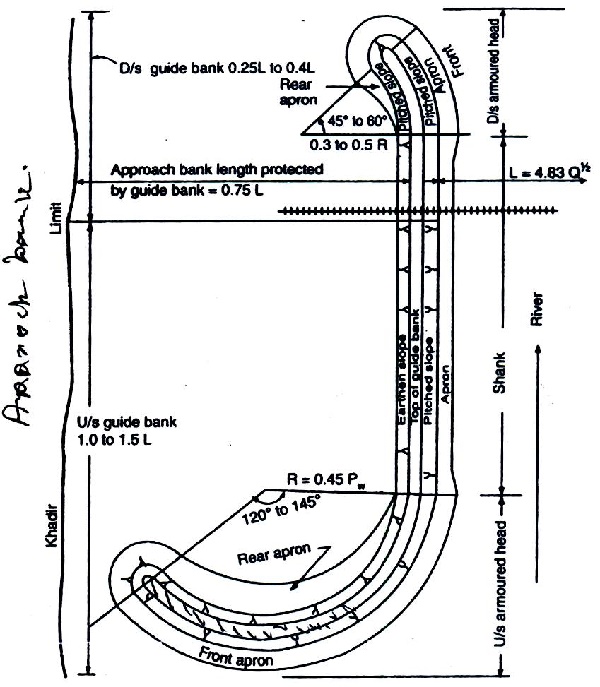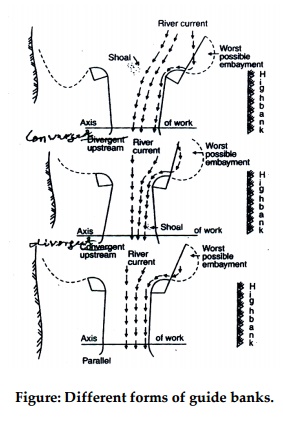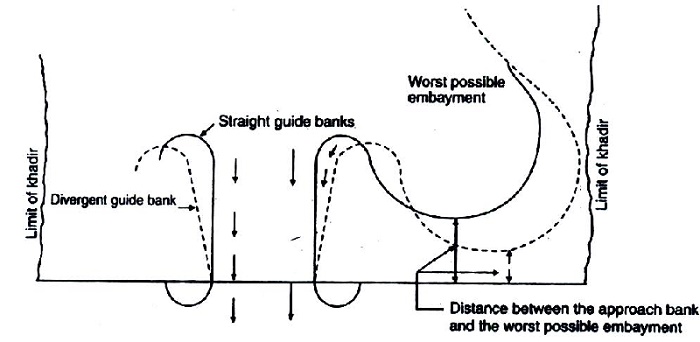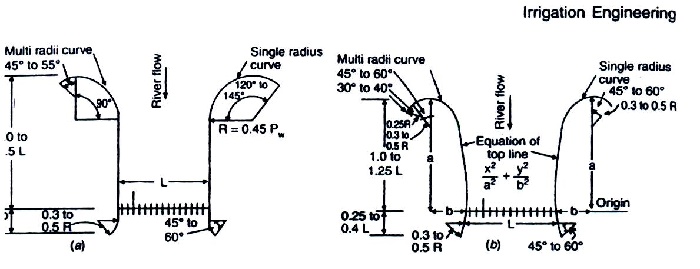Chapter: Civil : Water Resources and Irrigation Engineering : Diversion and Impounding Structures
Classification of Guide Banks
Guide Banks
Also called Bell’s bund. It is defined as the site of a barrage, weir, bridge, ect. To guide the river flow through the confined waterway without causing damage to the structure and its approaches. They are provided in the direction of flow, both upstream and downstream of the barrage of one or both flanks depending or requirement. The guide banks are usually provided in pairs, symmetrical in plan and may either

Figure: Layout of guide bank.
Functions of a Guide Bank: The functions served by a guide bank are (i) Economical spanning of a wide river, (ii) Safe and expeditions passage of floods, (iii) Protect adjacent lands, upstream of a weir or barrage from spills due to afflux caused by the barrage construction, (iv) control and confine the flow axially through a restricted waterway so that the river has no possibility to swing about and outflank the structure, (v) Prevent occurrence of crossflow immediately upstream of barrage, and (vi) Protect the approach embankments (on either side of a bridge extending from the river bank to the guide banks) from direct attack by the river.
Effects of Guide Banks: The effects of guide banks are (i) Increase in the rate at which flood wave passes down the river, (ii) Increase in maximum discharge at all points downstream, (iii) Rise in the water surface elevation of the river during flood, (iv) Increase in the velocity and scouring action through the embanked section, and (v) Reduction in water surface slope of the river above the embanked portion.
Classification of Guide Banks
1. According to Form in plan: The pair of guide banks may be parallel, divergent or convergent in plan upstream of the structure.
(a) Parallel guide banks. Where the river is likely to meander on both sides, parallel guide banks with suitable curved heads are essentially required to give uniform flow from the head of the guide bank to the work. Symmetrical and parallel guide bands figure are usually adopted unless local conditions warrant adoption of convergent or divergent banks; their suitability being indicated by model studies.
(b) Convergent guide banks: Convergent guide banks are rarely used. They have the disadvantage of excessive attack and heavy scour at the head and shoaling all along the shank rendering the end bays inactive.
Divergent guide banks. Divergent guide banks exercise an attracting influence on the flow and are indicated where approaching flow is oblique to the structure or work is located at one edge of khadir, in order to keep the flow active in the spans adjacent to them. However they provide relatively less protection to the approach embankment, under worst possible embayment Embayment. A localized widening of a river or channel brought out artificially or naturally, as compared to the equal length of parallel guide banks. The divergent guide banks thus require longer length in comparison to parallel guide banks for the same degree of protection to the approach embankment. They induce oblique flow onto the barrage and give rise to tendency of shoal formation in the centre due to larger waterway between curved heads.

Figure: Different forms of guide banks.

Figure: Extent of protection provided by the straight and divergent guide banks.
2. According to Geometrical Shape. On the basis of geometrical shape, the guide banks are classified as straight and elliptical with circular or multiradii curved head. Any other shape, if warranted by site conditions, is determined with the aid of hydraulic model studies.
Elliptical guide banks are preferred to the straight ones on account of the considerations (i) More suitable for wide flood plain rivers compared to straight guide banks, (ii) Flow hugs the guide banks all along their length due to gradual change in curvature, while separations of flow occurs in straight guide banks after the curved head which leads to obliquity of flow, and (iii) Provide better control on development and extension of meander loop towards the approach embankment.

Figure: Geometrical shapes of guide bank (a) straight guide bank, (b) elliptical guide bank.
Related Topics